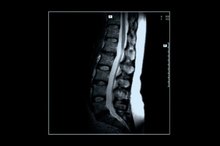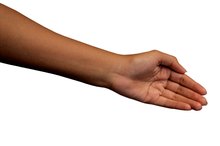C4 and C5 Nerve Damage Symptoms
The cervical spine is the region of the spinal column that supports the neck 4. Eight nerves emerge from between the cervical spinal bones, or vertebrae. These cervical nerves are referred to as C1 through C8. Each cervical nerve leads to different parts of the body and supports sensory, motor or organ function. When a nerve is damaged, the specific areas of the body that it serves can show symptoms.
If you are experiencing serious medical symptoms, seek emergency treatment immediately.
Muscle Weakness
The C4 and C5 nerves supply motor function to the muscles of the shoulder and arm. When either of these nerves is compromised, muscle weakness can result. Specifically, the C4 nerve enervates the levator scapulae, trapezius and rhomboid muscles. Damage to the C4 nerve may result in difficulty in elevating the shoulders. The C5 nerve supplies the deltoid, supraspinatus, infraspinatus and biceps muscles. Damage to the C5 nerve can affect the ability to raise the arm or bend it at the elbow.
- The C4 and C5 nerves supply motor function to the muscles of the shoulder and arm.
- Damage to the C5 nerve can affect the ability to raise the arm or bend it at the elbow.
Pain, Numbness or Paresthesia
Physical Therapy Treatment for a Long Thoracic Nerve
Learn More
Each cervical nerve detects sensory information from specific areas of skin, called dermatomes. When pain, numbness or paresthesia -- tingling or a pins-and-needles sensation -- appears over a specific dermatome, it could signify damage to the corresponding cervical nerve. The C4 nerve receives sensory input from the dermatome that covers the shoulder, collarbone and shoulder blade. Pain, numbness or paresthesia in these areas can signal damage to the C4 nerve. The C5 nerve receives sensory input from the dermatome located over the deltoid muscle at the uppermost part of the arm as well as the outer, upper arm.
- Each cervical nerve detects sensory information from specific areas of skin, called dermatomes.
- The C4 nerve receives sensory input from the dermatome that covers the shoulder, collarbone and shoulder blade.
Reflex Weakness
Doctors test tendon reflexes to determine the integrity of communication between the nerves in the extremities and the spinal cord or brainstem. A quick tap from a tendon hammer is used to test reflexes at specific sites in the body. The tap activates sensory receptors within the tendon, which sends a message stimulating a return message that causes the muscle to contract. There is no tendon reflex tested for the C4 nerve. Damage to the C5 cervical nerve can cause diminished tendon reflexes of the biceps and brachioradialis muscles. Tapping the brachioradialis tendon typically cause contraction of this muscle in the forearm, whereas tapping of the biceps tendon usually causes contraction of this muscle at the front of the arm above the elbow.
- Doctors test tendon reflexes to determine the integrity of communication between the nerves in the extremities and the spinal cord or brainstem.
- Tapping the brachioradialis tendon typically cause contraction of this muscle in the forearm, whereas tapping of the biceps tendon usually causes contraction of this muscle at the front of the arm above the elbow.
Respiratory Difficulties
Common Rear Shoulder Injuries
Learn More
C4 and C5, along with C3, supply the diaphragm -- the muscle that separates the chest and abdominal cavities. This muscle assists with breathing by creating more space in the chest and pulling air into the lungs when it contracts. Damage to these nerves, particularly C4, can disrupt the normal function of the diaphragm and result in difficulty breathing. However, this is rare unless the nerve damage is severe.
- C4 and C5, along with C3, supply the diaphragm -- the muscle that separates the chest and abdominal cavities.
- Damage to these nerves, particularly C4, can disrupt the normal function of the diaphragm and result in difficulty breathing.
Warnings and Precautions
Many conditions can damage your C4 and C5 nerves, most commonly a herniated disk or arthritis or traumatic injury to your neck. These conditions are usually treatable and you should not ignore your symptoms. See your doctor as soon as possible if you experience symptoms that might indicate damage to the C4 and C5 nerves. Seeking help sooner rather than later will typically speed your recovery.
Reviewed by: Tina M. St. John, M.D.
- Many conditions can damage your C4 and C5 nerves, most commonly a herniated disk or arthritis or traumatic injury to your neck.
Related Articles
References
- Orthopedic Physical Assessment; David J. Magee, Ph.D.
- American Family Physician: Cervical Radiculopathy: Nonoperative Management of Neck Pain and Radicular Symptoms
- Disorders of the Shoulder: Diagnosis and Management, Second Edition; Joseph P. Iannotti, M.D., Ph.D. and Gerald R. Williams Jr., M.D.
- Textbook of the Cervical Spine; Francis H. Shen, et al.
- Bonica's Management of Pain, 4th Edition; Scott Fishman, M.D., et al.
- Neurology in Clinical Practice: Principles of Diagnosis and Management, 4th Edition; Walter George Bradley, et al.
- Berciano J, Sedano MJ, Pelayo-Negro AL, García A, Orizaola P, Gallardo E, et al.. Proximal nerve lesions in early Guillain-Barré syndrome: implications for pathogenesis and disease classification. J Neurol. 2017 Feb;264(2):221-236. doi: 10.1007/s00415-016-8204-2. Epub 2016 Jun 17.
- Matejčík V, Haviarová Z, Šteňo A, Kuruc R, Šteňo J. Intraspinal intradural variations of nerve roots. Surg Radiol Anat. 2017 Dec;39(12):1385-1395. doi: 10.1007/s00276-017-1903-2. Epub 2017 Jul 29.
Writer Bio
For 15 years, Charis Grey's award-winning work has appeared in film, television, newspapers, magazines and on the Internet. She has worked as a story editor on the CBS drama "Flashpoint" and her work appears bimonthly in "The Driver Magazine." She has a Bachelor of Science in biology and a doctorate in chiropractic medicine from Palmer College.









